Manchu Strategic Offensive
The Soviet military-political leadership began preparations for an offensive in the Far East immediately after the Crimea Conference. The strategic goal of the Soviet operation was to defeat the Kwantung Army in Northeast China and Korea, on South Sakhalin and the Kuril Islands, which was to accelerate Japan’s surrender. The possibility of landing operations in Hokkaido was envisaged, if Tokyo did not capitulate after the loss of Manchuria and Korea.
The plan of the operation envisaged a powerful flank attack on the Kwantung Army from the west and east and an auxiliary strike from the north. This was supposed to lead to the fragmentation, encirclement and destruction of the Japanese army in parts. The liberation of Sakhalin and the Kuril Islands depended on the success of the main operation.
In accordance with the plan of the operation, organizational changes were carried out in the troops located in the Far East. In April 1945, from the two existing fronts - the Trans-Baikal and the Far East, the Primorsky Group was allocated, which included troops located from Guberovo to North Korea. This simplified command and control and allowed the command to concentrate forces in narrower bands. On August 2, 1945, the Primorsky Group was transformed into the 1st Far Eastern Front, and the Far Eastern Front into the 2nd Far Eastern Front. As a result, before the start of the war, three fronts were deployed in the Far East - Transbaikal, the 1st and 2nd Far Eastern. They had to interact with the Pacific fleet and the Red Banner Amur River Flotilla.
In order to inflict a crushing blow on the enemy and not delay the course of hostilities, the Supreme High Command Headquarters transferred some of the forces that had freed up in Europe to the Far East. The 39th Army was sent to the Trans-Baikal Front from the Konigsberg region, the 53rd Combined Arms and the 6th Guards Army from the Prague Region tank armies that were supposed to deliver the main blow in the west. The 1th Army, which was also located at the tip of the main strike, was transferred to the 5st Far Eastern Front from East Prussia. In addition, all fronts received new tank, artillery, aviation, engineering and other parts and connections. All this seriously increased the combat power of the Soviet Army in the Far East.
The troops were transferred to a distance 9-11 thousand kilometers, which was associated with great difficulties. Only during May-July, 1945 from the west 136 arrived in the Far East and Transbaikalia from the west with thousands of wagons carrying troops and cargo. Part of the way the troops had to overcome their course. Marches in Transbaikalia and Mongolia, where crossings reached more than 1000 kilometers, were especially difficult. Heat, clouds of dust, lack of water quickly tired people, impeded the movement of troops and accelerated the wear of machines. Despite this, daily infantry transitions reached 40 kilometers, and mobile units - 150 kilometers. As a result, all the difficulties of such a large-scale transfer of troops and weapons were successfully overcome.
The composition of the fronts in the Far East
As a result of all the rearrangements, the composition of the fronts in the Far East was as follows:
- The Trans-Baikal Front under the command of Marshal of the Soviet Union R.Ya. Malinovsky had 17, 39, 36 and 53 combined arms, 6-th Guards Tank Army, 12-th Air Army, Trans-Baikal Army, and Soviet-Mongolian horse-mechanized group;
- 1-th Far Eastern Front under the command of Marshal of the Soviet Union K.A. Meretskov had 35-th, 1-th Red Banner, 5-th, 25-th and 9-th air army, Primorsky Air Defense Army, Chuguevskoy operational group and 10 th mechanized body;
- The 2-th Far Eastern Front under the command of Army General M. A. Purkayev included the 2-th Red Banner, 15-th, 16-th combined-arms, 10-th air army, the Amur Air Defense Army, 5-th separate rifle division and Kamchatka defensive area .
General leadership was provided by the Commander-in-Chief of the Soviet troops in the Far East, Alexander Mikhailovich Vasilevsky. Colonel-General I.V. Shikin was a member of the Military Council, and Chief of Staff of the High Command in the Far East was Colonel-General S.P. Ivanov. The general leadership of aviation was carried out by the Air Force commander, Chief Air Marshal A. A. Novikov.
The three fronts included 11 combined arms, 1 tank, 3 air, and 3 air defense armies, a task force. In these formations, there were 80 divisions (of which 6 cavalry and 2 tank), 4 tank and mechanized corps, 6 rifle, 40 tank and mechanized brigades. In total, in the grouping of Soviet troops in the Far East there were over 1,5 million people, over 26 thousand guns and mortars, 5556 tanks and SPG, over 3,4 thousand aircraft. Soviet troops outnumbered the enemy in people in 1,8, in tanks in 4,8, in aviation in 1,9 times.
Pacific Fleet under Admiral JS Yumasheva had about 165 thousand. Personnel man, cruiser 2, 1 leader, destroyers 10, 2 destroyers, patrol ships 19, 78 submarines, mine-layers 10, 52 minesweeper, 49 hunters underwater boats, 204 torpedo boats and 1549 aircraft, 2550 guns and mortars. The Amur military flotilla under the command of NV Antonov had 12,5 thousand people, 8 monitors, 11 gunboats, 52 armored boats, 12 minesweepers and other ships, around 200 guns and mortars. The coordination of the actions of the Pacific Fleet and the Amur Flotilla with the ground forces was entrusted to the Commander-in-Chief of the Navy Admiral of the Fleet N. G. Kuznetsov.
Tasks fronts
The troops of the Trans-Baikal Front under the command of Malinovsky were to deliver the main attack with three combined-arms and tank armies (17, 53, 39 and 6-Guards Tank Armies) from the area of the Tamtsag-Bulag ledge in the general direction of Changchun and Mukden By the 15-th day of the operation, reach the Solun-Lubei-Dabanshan line, and then reach the Zhalantun-Changchun-Mukden-Chifeng line. On the flanks of the front troops inflicted two auxiliary strikes. In the north, the 36 Army was advancing, in the south, the Horse-mechanized group of Soviet-Mongolian troops.
Each army had its own task. The 17 Army under the command of Lieutenant-General A. I. Danilov was to strike from the Yugodzir-Khid area in the general direction of Dabanshan. 6-I Guards Tank Army under the command of Colonel-General Tank Forces A. G. Kravchenko was advancing in the general direction of Changchun. The tankers had to reach the line of Lubei, Tuquan, take the passes through Great Khingan, not allowing the Japanese reserves from the central and southern parts of Manchuria, then to attack Changchun and Mukden, no later than the 5 of the operation day.
The tank army was placed in the first echelon of the front, since before it there was neither a well-prepared defense of the enemy, nor significant forces of the Japanese. This made it possible to develop a rapid offensive, to occupy mountain passes before the enemy’s operational reserves approached and to develop success with a blow to the central regions of Manchuria, where they planned to destroy the main forces of the Japanese Japanese 3 front. The 6-I Guards Tank Army was significantly strengthened, with two mechanized, one tank corps, four separate tank battalions, two motorized rifle divisions, two self-propelled artillery brigades, two light artillery brigades, two artillery regiments, a separate reconnaissance regiment, a separate mortar regiment, a motorcycle regiment, two light artillery brigades, two artillery regiments, a separate reconnaissance unit motorized engineering brigade and other units. Thanks to such a powerful and heterogeneous composition, the tank army could conduct active hostilities in isolation from the combined arms armies.
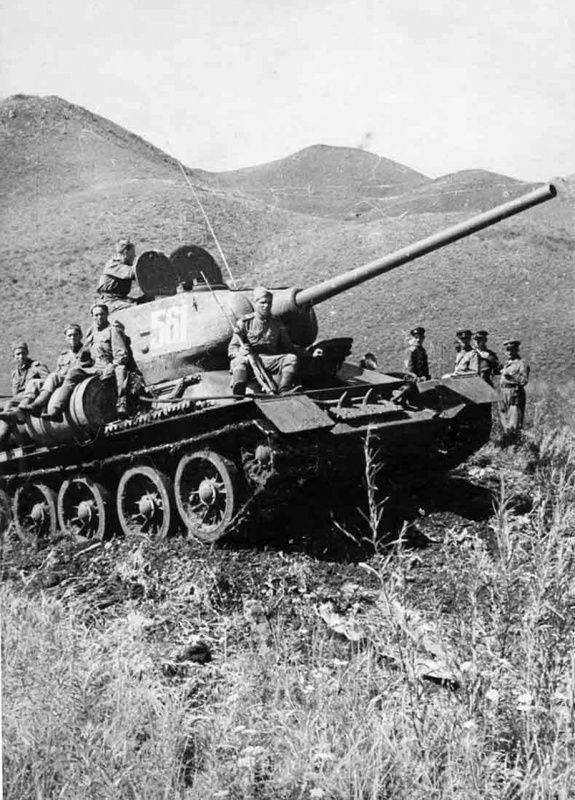
Tank T-34-85 in Manchuria on the ridge of the Great Khingan
Under the command of Colonel-General I. I. Lyudnikov, the 39-I army delivered the main blow from the region to the south-east of Tamtsag-Bulag in the direction of Solun, bypassing Khalun-Arshansky SD from the south. Lyudnikova's army was supposed to cut off the enemy’s path to the south-east by the Solun grouping and occupy the Solun area. A part of the army delivered an additional blow to the north-east in the general direction of Hailar in order to isolate the Solun group and support the 36 Army in defeating the Hailar group of the Japanese army.
The 36 Army under the command of Lieutenant General A. A. Luchinsky supported the offensive of the main attack force of the front from the north. The army of Lucinschi was advancing from the Starotsuruhaytuy area on Hailar with the task of taking the Hailar SD. Part of the army’s forces from the Otpor area attacked Zhalainor-Manchurian SD, and after its defeat it was also to head for Hailar. The 36 Army, in conjunction with part of the forces of the 39 Army, was to defeat the enemy Hailar grouping.
On the southern flank of the front, a Soviet-Mongolian Horse-mechanized group struck under the command of Colonel-General I. A. Pliev. KMG was advancing from the Moltsok-Khid region in the direction of Dolun (Dolonnor), ensuring the movement of the main strike force of the front from the right flank. This group consisted of the following Soviet troops: 43-I tank, 25-I and 27-I motorized rifle, 35-I fighter-anti-tank artillery brigade, 59-I cavalry division, two anti-aircraft, a fighter-aviation, guards mortar division, an army unit, and two anti-tank artillery brigade. battalion On the part of the Mongolian armed forces in the group were the 5-I, 6-I, 7-I and 8-I cavalry divisions, 7-I armored brigade, artillery regiment, air division and communications regiment.
The 53 Army under the command of I. M. Managarov was in the second echelon of the front. She was supposed to follow the tank army and was concentrated in the Tamtsag-Bulag area. There were two rifle and one tank divisions, one tank brigade in the reserve of the front. The reserve of the front was located in the Choibalsan area.
The troops of 1 of the Far Eastern Front of Meretskov were to deliver the main attack by the forces of two combined armies, a mechanized corps and a cavalry division (1 of the Red Banner and 5 of the Army, 10 of the Mechanized Corps) from the Grodekovo area in the general direction of Moulin, Mudanjiang to 23-th day of operation to reach the line of pain - Ninguta - Dongjingcheng - Sanchakou station. At the first stage of the operation, the main shock grouping of the front was to break through the powerful defenses of the enemy. The 1-th Far Eastern Front advanced towards the troops of the Trans-Baikal and 2-th Far Eastern Fronts. At the second stage of the operation, the front forces were to go to the Harbin-Changchun-Ranan line. Two auxiliary strikes with 35 and 25 armies were delivered north and south.
The 35 Army under the command of Lieutenant-General N. D. Zakhvataev was advancing to the north, ensuring the right flank of the main attack force of the front. Soviet troops were advancing from the area of Lesozavodsk in the direction of Mishan. The army of Zakhvatiev was to crush the opposing forces of the enemy and take over the Hutou SD, and then, in cooperation with the 1 of the Red Banner Army, destroy the Mishan group of the enemy.
The 1-I Red Banner Army under the command of Colonel-General A. P. Beloborodova, in cooperation with the 5-th army of the mulino-Mudanjiang Japanese grouping, was to take Mulin, Linko. By the end of 18, the day of the offensive the army was to reach the line of the Mudanjiang River north of the city of Mudandjiang. The 5 Army under Colonel-General N. I. Krylov was to break through the defense of Suyfing'he UR, and then attack Mudandzian in order to destroy the Mulino-Mudanjiang grouping in conjunction with the troops of the 1-th Red Banner Army. At the same time, part of the forces of the 5 Army was to advance south, entering the rear of the Japanese troops, who were defending themselves in front of the 25 Army.
The 25 Army under the command of Colonel-General I. M. Chistyakov supported the offensive of the main attack force of the front on the left flank. The 25 Army had to go on the offensive after breaking through the enemy defenses on the main line and using the success of the 5 Army to capture the Dunninsky Ur and then advance on Wangqing and Hunchun. Subsequently, with the support of the Pacific Fleet, they planned to land landings in the ports of North Korea.
A mobile group was formed at the front as part of the 10 Mechanized Corps and Cavalry Division. The reserve had two rifle corps. Part of the troops 1 of the Far Eastern Front (Chuguev Operative Group) continued to perform the task of defending the Soviet coast of the Sea of Japan.
The forces of the 2 Far Eastern Front Purkaev inflicted a strike from the north along the Sungari River at Harbin with the support of the Amur Flotilla by the forces of the 15 Th Armed Army. By day 23, the operations of the Soviet troops were to go to the area of the city of Jiamusi, and then Harbin. The remaining forces of the front at the beginning of the operation had the task of conducting defensive actions.
The 15 Army under the command of Lieutenant General S.K. Mamonova delivered the main attack from the Leninskoe area in the Sungarih direction and an auxiliary strike using the 5-th separate rifle corps from the Bikin area in the Zhaohei direction. With the support of two brigades of the Amur Flotilla and Aviation, the Army of Mamonov was to force the Amur on both sides of the Sungari River, take the city of Tongjiang, and develop an offensive against Jiamusi and Harbin. The remaining troops of the front were to go on the offensive on the second day of the operation.
The Pacific Fleet was supposed to disrupt enemy communications in the Sea of Japan; impede the actions of the enemy in the ports of North Korea; to provide their maritime traffic in the Sea of Japan and the Tatar Strait; in cooperation with ground forces, to prevent possible enemy landings on the Soviet coast. 8 August 1945. The fleet was ordered to be on alert, deploy submarines, stop the single navigation of Soviet ships, organize the escort of merchant ships. Later, in connection with the success of the ground forces, the fleet received additional tasks: to seize Japanese naval bases and ports in North Korea, on Sakhalin and the Kuril Islands. The Amur flotilla, operatively subordinate to the command of the 2 of the Far Eastern Front, was to ensure the crossing of the Amur and Ussuri rivers, to support ground forces in the storming of the EAs and the strongholds of the enemy.
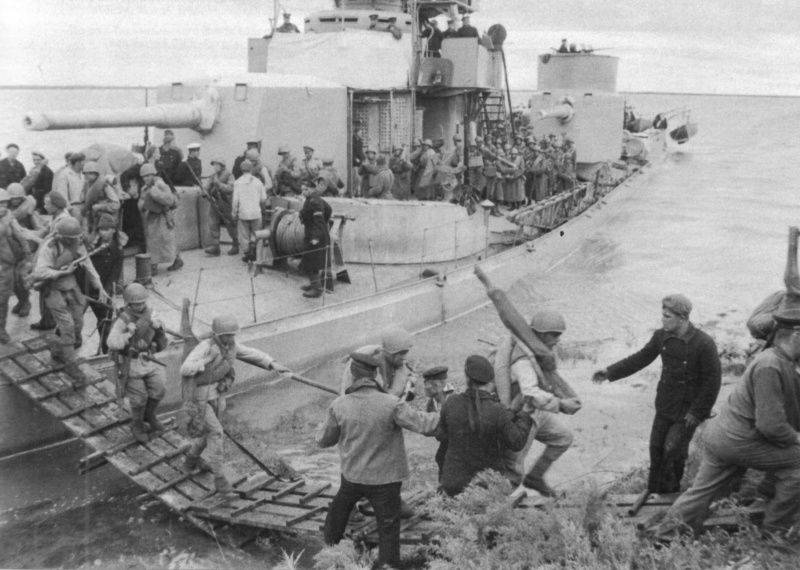
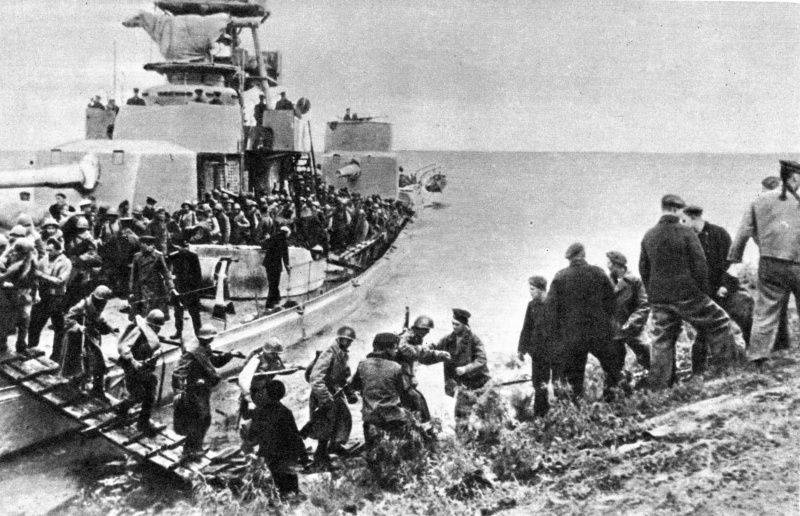
The landing of troops from the monitor of the Amur Flotilla on the river Sungari. 2 Far East Front
Thus, the offensive against the Japanese army was being prepared as a strategic operation of three fronts and a fleet. The Soviet troops had to deliver three dissecting strikes, converging in the center of Manchuria, which led to the encirclement, dismemberment and destruction of the Japanese Manchurian group. The depth of the operation of the Trans-Baikal Front was about 800 kilometers, for the 1 Far East — 400-500 kilometers, for the 2 Far East — more than 500 kilometers.
Each front had a different plan for artillery operations. In the armies of the Trans-Baikal Front, due to the fact that the main forces of the Kwantung Army were diverted deep into Manchuria, the artillery preparation was canceled. Only in the offensive zone of the 36 Army, where the two fortified areas of the enemy were stationed, should artillery suppress the strongholds of the Japanese army.
In the armies of the 1 of the Far Eastern Front, which needed to break through the heavily fortified enemy border with powerful guards, artillery had to play an important role at the start of the operation. The exception was the 1-I Red Banner Army, which was to attack in difficult mountainous and taiga areas, where the Japanese did not create a positional defense. The troops of the 1 th Red Banner Army were to strike suddenly, without artillery preparation.
The highest artillery densities were created in the 5 Army Band: 200 guns and mortars on the 1 km of front. The 5 Army was to break through the defense of the Pogranichnensky Fortified Area, the strongest on the border between the USSR and Manchuria. The night before the attack, 4-6 watchmaking artillery preparation was planned for previously defined targets. Before the attack of the main forces of the army, the second artillery preparation was planned.
In the 2 Far Eastern Front, in the offensive zone of the 15 Army and the 5 Infantry Corps, the artillery was to ensure the forcing of Cupid and Ussuri, the capture and retention of bridgeheads, and then the development of an offensive in the depth of enemy defense.
Aviation was to play a major role in the offensive operation. The 12-I air army under the command of Marshal of Aviation S. A. Khudyakov was to conduct reconnaissance to detect enemy troops; to cover ground troops from the strikes of Japanese aircraft; support the advance of the main strike force of the front; to prevent the approach of the enemy reserves on iron and dirt roads. The main efforts of aviation were focused on supporting the main strike force of the front. On the first day of the operation, Soviet aviation was to deliver massive strikes at Solun, Hailar, Halun-Arshan stations, bridges, trains, convoys and enemy airfields. This was supposed to disrupt the movement of troops and the transfer of enemy reserves.
9-I air army under the command of Colonel-General Aviation I. M. Sokolov, among other tasks, had to solve a special problem associated with the breakthrough of the enemy’s long-term defense. On the first day of the attack, secular planes were to deliver massive blows to the defense units and enemy strongholds. The assault aircraft were supposed to support the offensive of the ground forces with continuous strikes.
The 10 Airborne Army, commanded by Colonel-General Aviation PF Zhigarev, was to concentrate the main efforts in the main attack zone, that is, to support the 15 Army’s advance. Fighter aircraft had to reliably cover the ground forces, Amur flotilla ships, as well as railways from attacks by Japanese aircraft. The assault and bomber aircraft were to strike at defensive positions, ships of the Sungarii flotilla and suitable reserves of the enemy. The air force of the Pacific Fleet had the task of attacking the naval bases of the Japanese fleet in North Korea, as well as operating at sea, destroying Japanese aircraft at airfields and covering our ships.
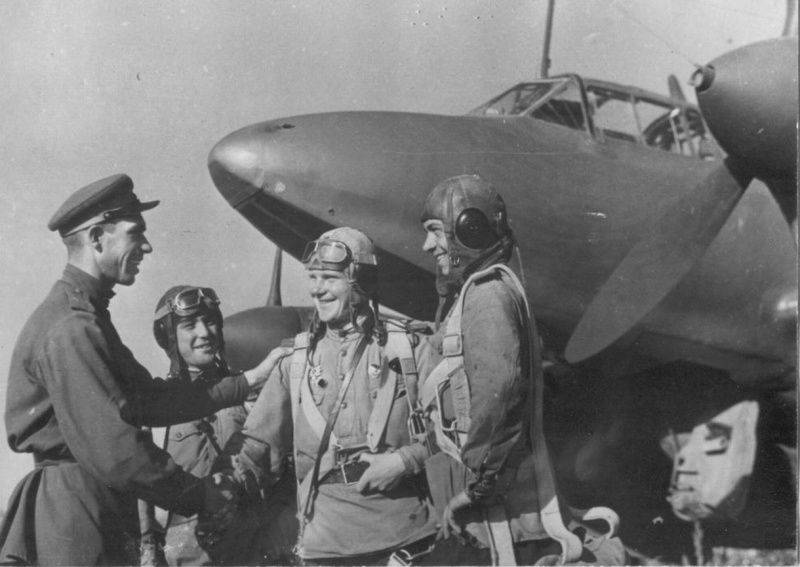
Pe-2 bomber on the 1 Far Eastern Front
To be continued ...
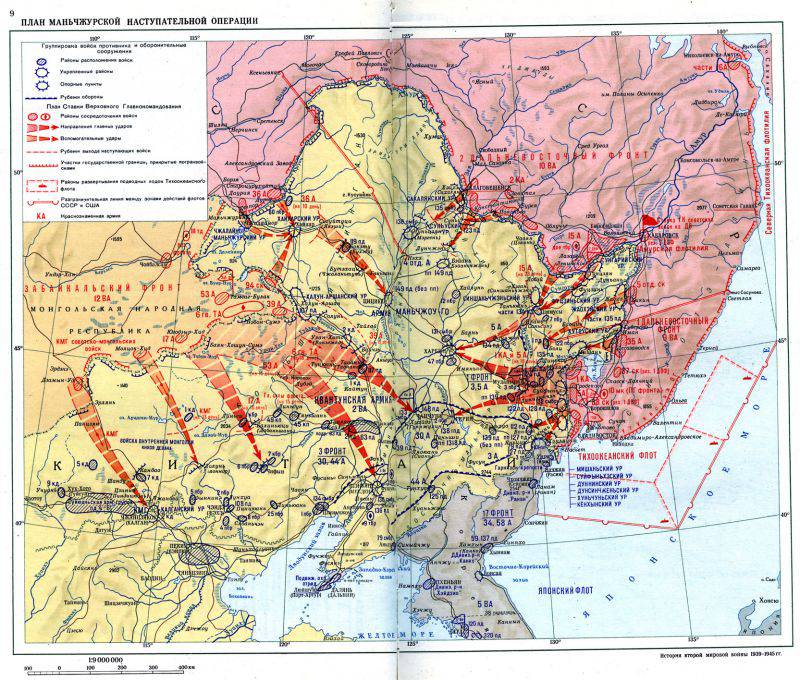
Information